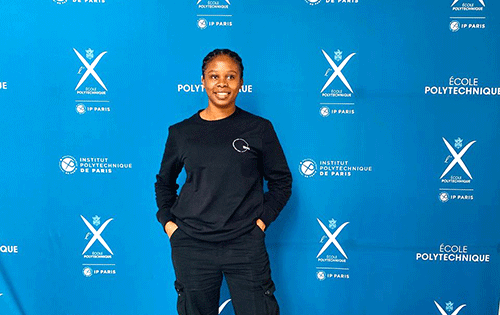Tuwilika Simon, a Master’s student in Physics at the University of Namibia (Unam), is breaking strides in the study of Active Galactic Nuclei (AGNs).
Her focus is on resolving the acceleration to very high energies along the jet of Centaurus A using High Energy Stereoscopic System (HESS) data.
She recently headlined the Cherenkov Astronomy Data School (CADS 2024), held in Paris, France.
The event, which brought together leading minds in gamma-ray astronomy, provided her with an opportunity to expand her research knowledge in one of the world’s most respected academic settings.
Her research aims to unravel the complex physics governing the extreme environments found in AGNs, which are thought to harbour supermassive black holes at the centres.
The jets emanating from these black holes are capable of accelerating particles to near-light speeds, producing some of the highest-energy phenomena in the universe.
Simon said attending CADS 2024 helped her understand many aspects of gamma-ray astronomy.
She learned aspects of gamma-ray statistics, which was quite challenging; how gamma rays are produced, and the processes involved in their formation.
She learned how Cherenkov telescopes detect gamma rays, how data is collected, and how to analyse observations using Gammapy, a Python-based tool used for processing data from telescopes like H.E.S.S.
“The school was a great opportunity to meet experts and other researchers, exchange ideas, and deepen my understanding of the field.
“My motivation comes from curiosity about how the universe works, how black holes form, and how gamma rays are produced around black holes and jets. I am especially interested in studying extreme environments like AGNs, black holes and jets.
“Gamma rays come from powerful and energetic events in these environments. By studying them, we can learn more about how particles are accelerated, and the nature of cosmic rays,” Simon said.
She added that she struggled the first day because she arrived late for the first session of introducing the software.
She was busy getting lost in the city of love while trying to find the Observatoire de Meudon conference room.
However, by the next day, she started to gain a better understanding.
“Gammapy is a well-structured and user-friendly tool once you get the hang of it. And the documentation online has tutorials one can play with to understand further,” she added.
Gammapy plays a crucial role in Cherenkov Telescope observations, as it provides an open-source framework for analysing gamma-ray data.
It allows researchers to process and interpret observations from Cherenkov telescopes, making it a key tool for studying high-energy astrophysical sources.
By learning Gammapy, she has gained valuable skills that will help her work with data from instruments like H.E.S.S. and, in the future, Cherenkov Telescope Array.
“I aspire to contribute to the field of astronomy, and continue with research in gamma-ray astronomy. My goal is to better understand extreme cosmic environments, including AGNs, jets and black holes, with a focus on the physics of jets, and how particles are accelerated in AGNs. Attending the CADS has given me the skills and introduced me to Gammapy, a tool I am likely to use in my future research,” she added.
-pmukokobi@nepc.com.na


